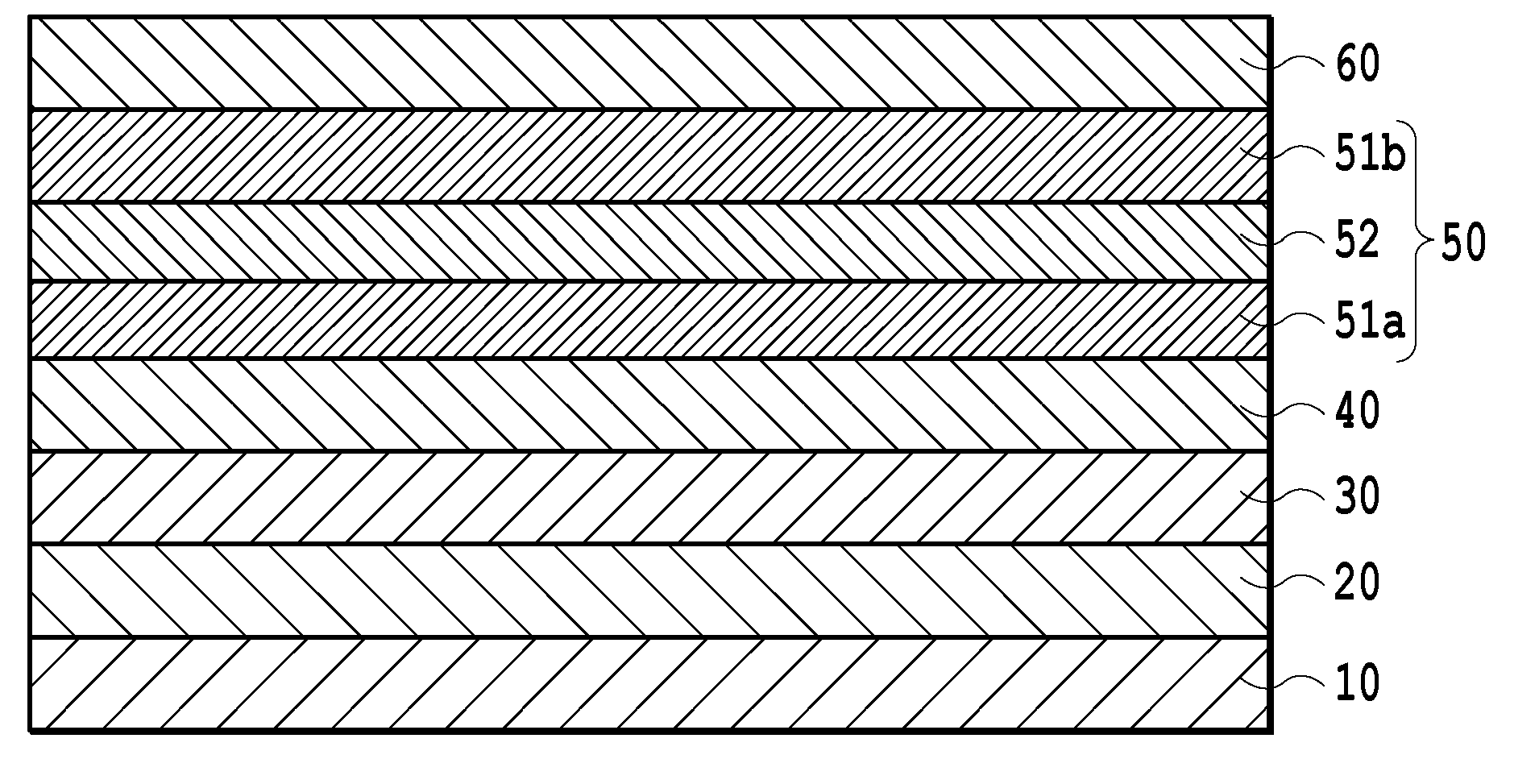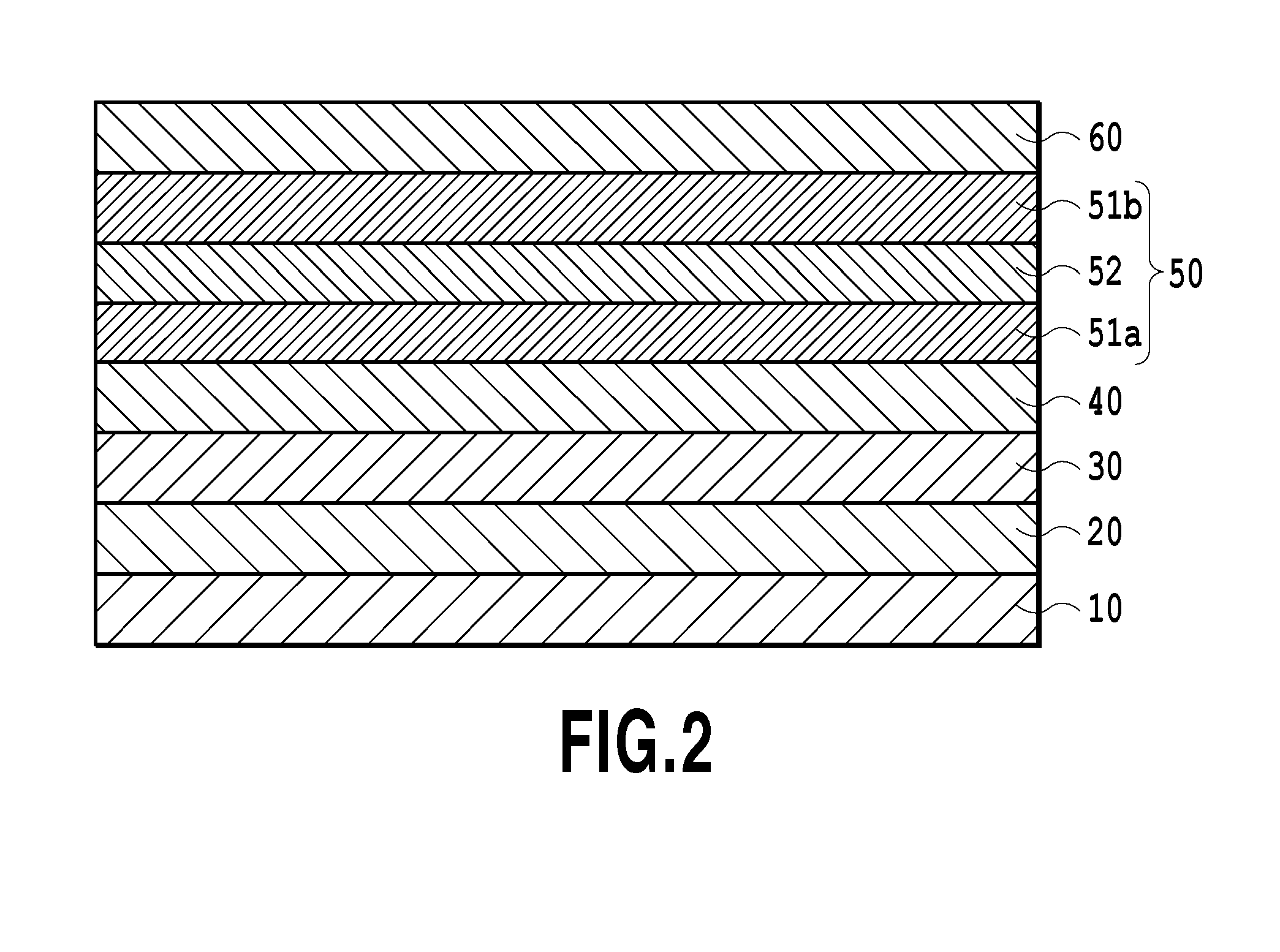Perpendicular magnetic recording medium
- Summary
- Abstract
- Description
- Claims
- Application Information
AI Technical Summary
Benefits of technology
Problems solved by technology
Method used
Image
Examples
example 1
[0081]A chemically strengthened glass substrate having a flat surface (N-10 glass substrate manufactured by HOYA CORPORATION) was washed to prepare non-magnetic substrate 10. The washed non-magnetic substrate 10 was brought into a sputtering device. Then, Ta adhesive layer 20 having a thickness of 5 nm was formed by a DC magnetron sputtering method using a pure Ta target in Ar gas at a pressure of 0.3 Pa.
[0082]Next, Cr interlayer 30 having a thickness of 20 nm was formed by a DC magnetron sputtering method using a pure Cr target in Ar gas at a pressure of 0.3 Pa.
[0083]Next, the substrate was heated to a temperature of 300° C., and then MgO seed layer 40 having a thickness of 5 nm was formed by an RF sputtering method using an MgO target in Ar gas at a pressure of 0.18 Pa. The applied RF power was 100 W.
[0084]Next, the stacked body in which the seed layer 40 had been formed was heated to a temperature of 450° C., and then FePt—C first magnetic recording layer 51 having a thickness of...
example 2
[0099]A magnetic recording medium was obtained by repeating the procedure of Example 1, except for the following differences.
(a) The stacked body in which the adhesive layer 20 had been formed was heated to a temperature of 400° C., and then an MgO intermediate layer having a thickness of 1 nm was formed by an RF sputtering method using an MgO target in Ar gas at a pressure of 0.1 Pa. The applied RF power was 100 W. The Cr interlayer 30 was formed onto the MgO intermediate layer.
(b) The composition of the second magnetic recording layer 52 was changed to 75% by volume of Fe50Pt50 and 25% by volume of ZnO. The thickness of the second magnetic recording layer 52 was changed to 3 nm.
(c) The protective layer 60 was changed to a stacked structure of a Pt layer having a thickness of 5 nm and a Ta layer having a thickness of 5 nm. The Ta layer was formed by a DC magnetron sputtering method using a pure Ta target in Ar gas at a pressure of 0.3 Pa.
[0100]The magnetic recording medium of this ...
example 3
[0107]Layers up to the MgO seed layer 40 were formed in accordance with the same procedure as Example 1.
[0108]Next, the stacked body in which the seed layer 40 had been formed was heated to a temperature of 450° C., and then first FePt—C first magnetic recording layer 51a having a thickness of 2 nm was formed by a DC magnetron sputtering method using a target containing Fe50Pt50 and C in Ar gas at a pressure of 1.5 Pa. Here, the composition of the Fe50Pt50—C target was adjusted such that the obtained first magnetic recording layer 51a had a composition of 60% by volume of Fe50Pt50 and 40% by volume of C. The applied DC power was 40 W.
[0109]Next, FePt—ZnO second magnetic recording layer 52 having a thickness of 1 nm was formed by a DC magnetron sputtering method using a target containing Fe50Pt50 and ZnO in Ar gas at a pressure of 1.5 Pa, in the state that the stacked body was heated at a temperature of 450° C. Here, the composition of the Fe50Pt50—ZnO target was adjusted such that t...
PUM
 Login to View More
Login to View More Abstract
Description
Claims
Application Information
 Login to View More
Login to View More - R&D Engineer
- R&D Manager
- IP Professional
- Industry Leading Data Capabilities
- Powerful AI technology
- Patent DNA Extraction
Browse by: Latest US Patents, China's latest patents, Technical Efficacy Thesaurus, Application Domain, Technology Topic, Popular Technical Reports.
© 2024 PatSnap. All rights reserved.Legal|Privacy policy|Modern Slavery Act Transparency Statement|Sitemap|About US| Contact US: help@patsnap.com










